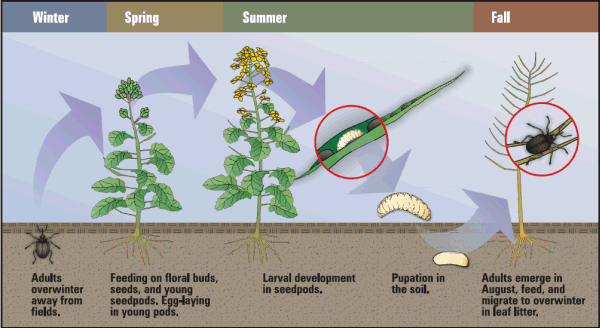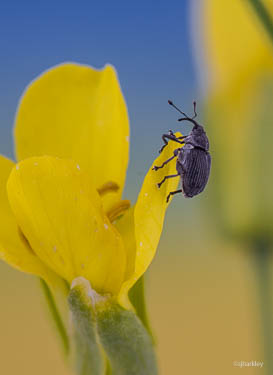| |

Cabbage seedpod weevil was first found infesting canola in southern Alberta in 1995. Since then, the weevil has spread to south-central Alberta and southwestern Saskatchewan. The distribution and abundance of the cabbage seedpod weevil has been monitored yearly in western Canada since 1997.
Predictive models based on climate data indicate that this pest will eventually disperse to all regions of canola production in western Canada, including the Peace Region.
The 2016 survey covered all the canola growing areas of Alberta with 218 fields sampled in 48 municipalities and 68 calls from our online reporting tool. | |
Expansion of cabbage seedpod weevil from 2011 to 2016
The cabbage seedpod weevil was once again found at economic levels in southern Alberta including the Municipal District of Pincher Creek. In addition economic levels of cabbage seedpod weevil was found well north of Highway 1 into central Alberta. It will now be important to scout to make control decisions as far north as a line from Red Deer east to Consort Alberta.
As well as the expansion of the range in which cabbage seedpod weevil are found pushed even further north into Ponoka, Camrose, Flagstaff and Wainwright. This expansion is once again further north than any range expansions in the past. Other northern range expansions in the past did not persist so it will be important to watch the population over the next couple years.
While this is not a true forecast, the numbers of weevils found through this survey in southern Alberta and the southern counties of central Alberta indicate a potential of economically damaging populations in the next growing season. Any producers growing canola in southern Alberta and into the south portion of central Alberta will have to check their canola crops as they come into flower.
The earliest flowering canola crops tend to have the highest risk from cabbage seedpod weevil and should be monitored very closely.
Cabbage seedpod weevil overwinters as an adult so the risk of infestation is further indicated by the adult population of the preceding fall. High numbers of weevil adults in fall will likely mean significant infestation levels in the following spring. This map does not adjust for the emergence of the new generation in the fall or overwintering conditions, although cooler temperatures and rainfall in August favors the development of the new weevil generation and may lead to higher numbers in the following year.

The cabbage seedpod weevil life cycle
The cabbage seedpod weevil takes roughly eight weeks to develop from egg to adult. Development time will vary somewhat depending on weather conditions, especially temperature. There is one generation per year. Follow this link for further information about the life cycle.
Crop damage from cabbage seedpod weevil can occur from:
- bud-blasting (potentially reducing yield in dry years)
- larval feeding within developing pods (larva consumes five to eight seeds, this is the major source of losses)
- premature shattering of damaged pods
- new generation adults that emerge in the fall feeding on nearly developed seeds (only on very late crops)
The larval feeding alone can result in yield losses of 15 to 20 percent in each pod infested.
| Cabbage seedpod weevil adult abundance is best monitored by using sweep net sampling. Sampling should begin when the crop first enters the bud stage and continue through the flowering period. Select ten locations within each field, and at each location count the number of weevils from ten 180 degree sweeps. Sampling locations should include both the perimeter and interior of the field to obtain a representative estimate of weevil numbers throughout the field.
This monitoring procedure will also give an indication of the number of lygus bugs present and may serve as an early warning for lygus damage, provided that the same fields are monitored into the early pod stage. |
 Cabbage seedpod weevil adult
Shelley Barkley
Alberta Agriculture and Forestry
Cabbage seedpod weevil adult
Shelley Barkley
Alberta Agriculture and Forestry |
The 2016 cabbage seedpod weevil survey was carried out by Alberta Agriculture and Forestry with support from the Applied Research Associations (Farming Smarter, Chinook Applied Research Association and Lakeland Applied Research Association) and from the web based reporting tool. Thank you for your contribution.
Special mention to Jennifer Otani, Agriculture and Agri-Food Canada, Beaverlodge for the canola survey in the Peace region where NO cabbage seedpod weevils have been found to this point.
Thank you David Giffen, Agriculture and Agri-Food Canada, Saskatoon for preparing the map.
Thank you to Jan Lepp, Alberta Agriculture and Forestry for managing the data from this survey.
Frequently Asked Questions
Canola Council of Canada
For more information on this insect and its management contact the Ag-Info Centre at 310-FARM (3276) or bugs.r.us@gov.ab.ca
Historic survey maps of cabbage seedpod weevil from 2009-2015. |
|